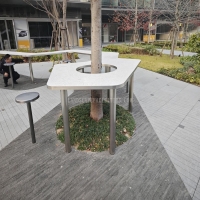Welcome to the website for landscape facilities products and knowledge.
How does the placement of a landscape bar counter affect traffic flow in an outdoor entertainment area?
The placement of a landscape bar counter serves as a critical design decision that directly influences circulation patterns, social dynamics, and overall functionality within an outdoor entertainment area. Unlike indoor settings, outdoor spaces present unique challenges and opportunities for managing guest movement while maintaining aesthetic harmony with the natural environment.
A centrally located bar counter often functions as a powerful anchor point, naturally drawing guests into the space and creating a clear focal point for socialization. This positioning encourages circular traffic flow around the perimeter of the entertainment zone, preventing bottleneck formation while allowing seamless access to seating clusters, cooking areas, and other amenities. The counter becomes the heart of the outdoor room, with pathways radiating outward like spokes from a wheel.
Perimeter placement, conversely, creates distinct functional zones by acting as a boundary element. This approach works particularly well in narrower spaces or areas requiring clear separation between dining, cooking, and relaxation sections. By positioning the bar along one edge, designers create uninterrupted pathways behind guests seated at the counter, maintaining fluid circulation even during peak entertaining hours. This layout often maximizes usable space while providing a sense of enclosure and intimacy.
The relationship between the bar counter and primary pathways demands careful consideration. Positioning the service side adjacent to main circulation routes allows guests to access beverages without intruding on seated conversations, while keeping the bartender connected to both guests and preparation areas. Maintaining 36-48 inches of clearance behind seated guests ensures comfortable passage while preventing feelings of congestion.
The bar's orientation relative to other key features—particularly cooking stations and seating groups—further determines traffic patterns. A perpendicular arrangement between the bar counter and grill area often creates a natural "working triangle" that facilitates efficient service while separating food preparation traffic from general guest circulation. Angled placement at 45 degrees to main pathways can soften rigid geometries and create more dynamic, organic movement through the space.
Environmental factors equally impact flow dynamics. Positioning the counter downwind from prevailing breezes prevents smoke and cooking odors from disrupting guests, while orientation away from direct afternoon sun enhances comfort during daytime events. Overhead structures or strategic landscaping can define the bar area without creating physical barriers that might disrupt movement.
Ultimately, successful bar counter placement balances multiple objectives: creating intuitive pathways, fostering social interaction, maximizing space efficiency, and enhancing the overall guest experience. By treating the bar as both a functional element and a circulation management tool, designers can transform outdoor entertainment areas into seamlessly flowing environments that feel both expansive and intimate, lively yet effortlessly navigable.
Related search:

Recommendation
An outdoor bar counter with stainless steel and terrazzo materials in an irregular shape